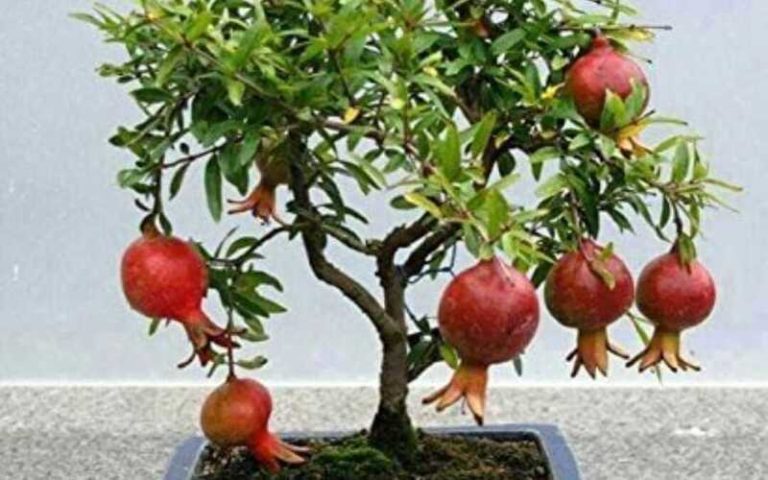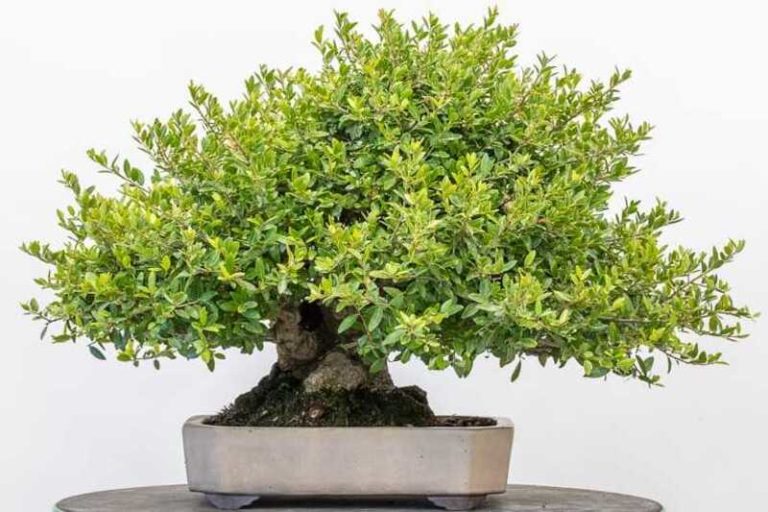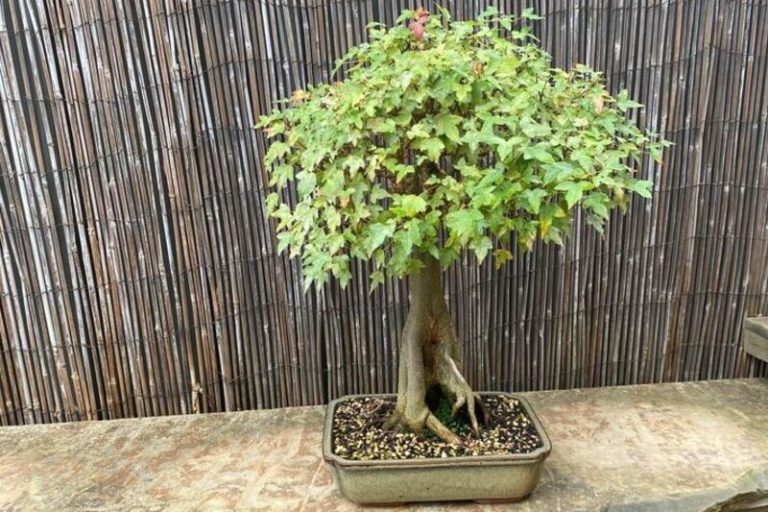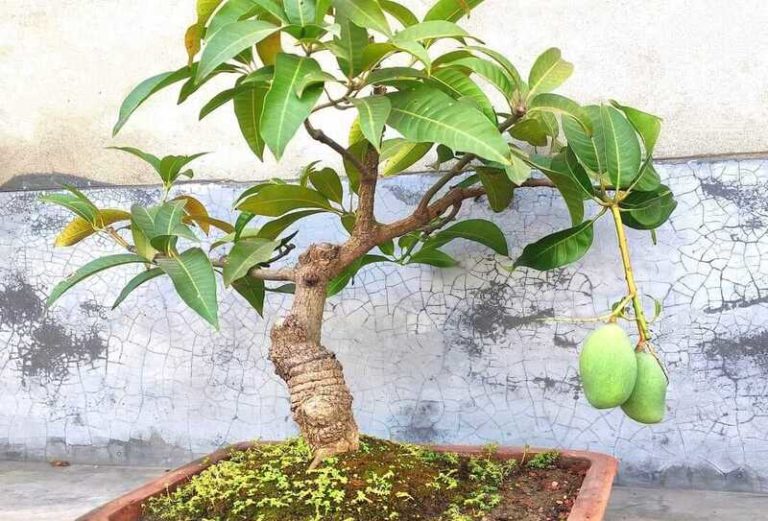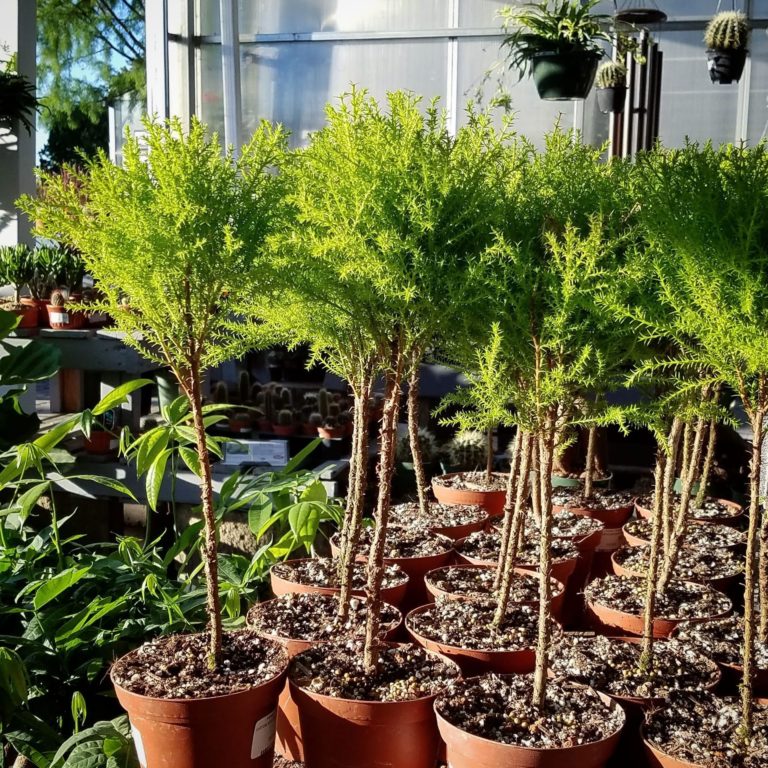Bonsai Rock Planting: Exploring the Harmony of Trees and Rocks
Bonsai rock planting is a captivating art form that allows you to create miniature landscapes with rocks and bonsai trees. It combines the beauty of nature with the skillful manipulation of plants and stones. In this article, we will explore the basics of bonsai rock planting and how you can start your own unique creation.
What is a Bonsai Rock Planting?
Bonsai rock planting is a type of bonsai care that involves putting rocks into the tree’s pattern and how it looks. In this form of art, the rocks are used as a base or support for the bonsai tree, making a natural-looking scene that looks good. The rocks have been carefully chosen and put in place to look like mountains, hills, and other natural features. Bonsai rock plantings take skill and creativity to create a balance between the rocks and the tree, which results in a small-scale show of nature that is both beautiful and peaceful. This type of art came from China and Japan, but it has become famous all over the world because it is unique and beautiful.
History and Origins of Bonsai Rock Planting
The history and origins of bonsai rock planting can be traced back to ancient China and Japan, where the art of bonsai itself originated.
China:
In China, the practice of growing and shaping miniature trees dates back over a thousand years. It was during the Tang Dynasty (618–907 AD) that the art of penjing, which means “tray scenery,” emerged. Penjing involved creating miniature landscapes in trays or shallow containers, incorporating rocks and plants. This practice laid the foundation for the later development of bonsai.
Japan:
Chinese penjing had a big impact on bonsai as we know it today. It was brought to Japan by Buddhist monks in the 12th century. They used it as a way to practice meditation and spirituality by growing and teaching small trees.
Bonsai grew into its own art form in Japan. Its name comes from the Japanese words for “tray cultivation” or “planting in a shallow container.” Bonsai was a way for the Japanese to show how much they loved nature and to develop a feeling of unity and balance.
From the beginning of Japanese bonsai, rocks have been used as part of the design. Japanese bonsai artists got ideas from their country’s rough and beautiful scenery, like mountains and rocks. They tried to make tiny versions of these nature scenes by using rocks to show how the land was formed.
During the Edo era (1603–1868) in Japan, the idea of putting rocks in small pots became popular. “Ishizuke,” which means “planting on rocks,” became famous during this time. Ishizuke was the art of making bonsai arrangements on rocks, with a focus on how the tree and the rock fit together to make an accurate picture of nature.
Bonsai rock planting has grown and changed as an art form over the years, with artists trying out new techniques and styles to make tiny landscapes that are both beautiful and expressive. Today, people all over the world do bonsai rock planting and respect it. They continue to push the limits of creativity and innovation in this unique way of growing bonsai.
Bonsai Rock Planting and its Symbolism
Bonsai rock plantings hold deep symbolism that reflects the connection between humans and nature. Here are some of the key symbolic elements associated with bonsai rock plantings:
- Harmony: Bonsai rock plantings symbolize the harmony between the natural elements, representing the unity of rocks, trees, and the surrounding environment. The rocks represent stability and permanence, while the bonsai tree represents the fleeting nature of life. Together, they create a balanced and harmonious composition.
- Natural Beauty: Bonsai rock plants show the beauty of nature in a small way. They show a respect for how beautiful nature is and how it can make people feel awe and peace. The rocks and trees have been carefully chosen and put together to create a sense of nature wonder and peace.
- Resilience: The rocks in bonsai rock plantings symbolize strength and endurance. Just as rocks weather the elements over time, bonsai trees planted on rocks demonstrate resilience and the ability to adapt to challenging conditions. The combination of these elements represents the resilience and endurance of the human spirit.
- Reflection of Landscape: Bonsai rock plants try to make small versions of bigger natural settings and catch their spirit. Bonsai artists try to capture the beauty and spirit of mountains, hills, and other natural forms by carefully choosing and arranging rocks, trees, and other elements. The small-scale environment is a reflection of the bigger world and lets people connect with nature on a more personal level.
- Balance and Tranquility: Bonsai rock plantings embody the principles of balance and tranquility. The arrangement of rocks and trees creates a sense of visual harmony and tranquility, inviting viewers to find inner peace and contemplation. The subtle curves, textures, and asymmetry of the composition contribute to a sense of natural equilibrium.
- Time and Patience: Bonsai rock plantings symbolize the passage of time and the value of patience. The slow and deliberate process of cultivating bonsai trees and arranging rocks requires dedication and a long-term perspective. Bonsai artists must nurture and care for their creations over many years, emphasizing the importance of patience, persistence, and respect for the natural growth process.
Bonsai rock plantings are not only aesthetic displays but also meaningful representations of our relationship with the natural world. They encourage us to appreciate the beauty, harmony, and resilience of nature and inspire us to find balance and tranquility in our own lives.
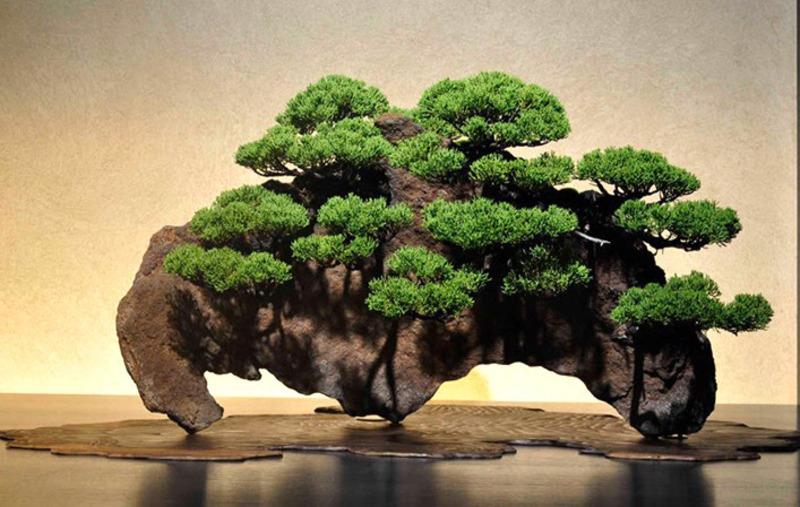
Characteristics of the Bonsai Rock Planting
Bonsai rock plantings possess distinct characteristics that set them apart from other forms of bonsai cultivation. Here are some key characteristics of bonsai rock planting:
Integration of Rocks: The prominent characteristic of bonsai rock planting is the deliberate incorporation of rocks into the overall composition. Rocks are selected based on their shape, size, texture, and color to create a natural and visually appealing landscape. The rocks serve as the foundation or base on which the bonsai tree is planted, emphasizing the harmony between the tree and its rocky environment.
Naturalistic Aesthetic: Bonsai rock plantings strive to recreate natural landscapes in miniature form. The arrangement of rocks, trees, and other elements aims to mimic the natural scenery found in mountains, cliffs, or rocky terrains. The overall design and placement of these elements follow the principles of asymmetry, irregularity, and the illusion of age to achieve a naturalistic and realistic aesthetic.
Erosion and Weathering Effects: Bonsai rock plantings often incorporate the concept of erosion and weathering to add depth and realism to the composition. Artists may use techniques such as carving or creating artificial erosion patterns on the rocks to simulate the effects of wind, water, and time. These effects give the rocks a weathered appearance and contribute to the overall authenticity of the miniature landscape.
Visual Balance: Achieving visual balance is a critical aspect of bonsai rock plantings. The placement and positioning of rocks, as well as the bonsai tree, are carefully considered to create a sense of equilibrium and harmony. Artists aim to distribute visual weight evenly throughout the composition, ensuring that no element dominates or feels out of place.
Use of Accent Elements: Bonsai rock plantings may include accent elements such as moss, gravel, small figurines, or miniature structures to enhance the overall composition. These elements add visual interest, create focal points, and contribute to the storytelling aspect of the miniature landscape. For example, moss can be used to mimic the lush vegetation that often grows on rocks in natural settings.
Long-Term Development: Bonsai rock plantings require long-term development and care. The integration of rocks and the growth of bonsai trees are ongoing processes that evolve over time. Artists must regularly maintain and refine the composition, including pruning, wiring, and repotting the bonsai tree, to maintain its desired shape and overall aesthetic.
Bonsai rock plantings offer a unique and captivating way to showcase the beauty of nature in miniature. The deliberate integration of rocks, the emphasis on naturalistic aesthetics, and the careful balance of visual elements contribute to the distinct characteristics of this art form.
Types of Bonsai Rock Planting
There are several types of bonsai rock plantings that vary in style, design, and overall aesthetic. Here are a few common types of bonsai rock planting:
1. Mountain Landscape: Mountain landscape bonsai rock plantings aim to recreate the grandeur and ruggedness of mountainous regions. They often feature tall, vertically oriented rocks that resemble towering cliffs or peaks. The bonsai tree is positioned to evoke the sense of a tree clinging to a rocky outcrop, emphasizing the resilience and adaptability of nature.
2.Waterfall Scene: Waterfall scene Bonsai rock plantings bring to mind the peaceful beauty of water falling over rocks. The way the rocks are set up makes it look like a waterfall, and the bonsai tree is near where the water is running. Most of the time, moss, small models, or rocks are used in this type of planting to make it look like the environment and add to the water theme.
3. Cliff Formation: Creating a cliff The height and drama of rocky hills are emphasized in bonsai rock plants. In this style, the rocks are often rough and broken to look like the way cliffs have been worn down over time. The bonsai tree is usually placed so that its shape and direction match those of the rocks around it. This gives the tree and its surroundings a sense of unity and balance.
4. Seaside Landscape: Seaside landscape bonsai rock plantings evoke coastal beauty, featuring rocks that resemble cliffs or shorelines. The bonsai tree is positioned to evoke the sense of a tree growing near the ocean, with the rocks representing the coastal features. Elements such as sand, small pebbles, and driftwood may be incorporated to enhance the seaside theme and create a serene coastal atmosphere.
5. Gorge or Canyon: Gorge or canyon bonsai rock plants try to look like the narrow, deep, and twisting shapes of gorges or canyons. In this style, the rocks are set up to look like a winding river or road, and the bonsai tree is put so that it looks like it is growing in a rocky canyon. The design often uses moss or ground cover to make it look like plants are growing among the rocks.
6. Zen Garden: The bonsai rock plants in a Zen garden are all about simplicity, minimalism, and peace. In a Zen garden, the rocks are often smooth and put in a way that makes them look like islands or land masses. The bonsai tree is placed in a way that makes you feel calm and in balance. In this style, sand or gravel is often raked into designs to look like water or waves and create a calm atmosphere.
These are just a few different types of bonsai rock plants. Each style looks different and makes you feel or think of something different. Bonsai fans can try out different styles and come up with their own versions, which shows off their creativity and personal taste in art.
How to Grow a Bonsai Rock Plant
Several elements must be carefully considered while growing a bonsai rock plant. Here’s how to develop a bonsai rock plant step by step:
Selecting Rocks and Bonsai Trees: Choose rocks that have interesting shapes, textures, and colors. Look for rocks with natural crevices or holes that can accommodate the roots of the bonsai tree. Ensure the rocks are clean and free from harmful substances. Select a bonsai tree that is suitable for rock planting, considering its size, species, and compatibility with the chosen rocks.
Preparing the Rocks: Clean the rocks well to get rid of any dirt or other junk. To kill any bugs or diseases that might be on the rocks, soak them in a mix of water and weak bleach or vinegar. After that, give the rocks a good wash. Make little holes or pockets in the rocks for the bonsai tree’s roots. Make sure that when the rocks are put together, they are stable and safe.
Preparing the Bonsai Tree: You can prune the bonsai tree to make it look and grow the way you want. Take off any stems and leaves that are dead, broken, or too many. If you need to, you can wire the twigs to help them grow in the shape you want. Before placing, make sure the tree’s roots are healthy and not twisted.
Planting the Bonsai Tree in Rocks: Make holes or spaces in the rocks where you can put the roots of the bonsai tree. Place the roots gently in these spaces, making sure they have enough room to grow and take hold. The dirt and base mixture is layered around the roots to give them enough food and support. After putting the bonsai tree, water it carefully to settle the dirt and make sure it gets enough water.
Designing the Composition: Place the rocks and bonsai tree in a way that looks natural and looks good to the eye. Try out different layouts and angles to find the best design. Think about how the rocks and tree are balanced, symmetrical, and fit together as a whole. You can also add moss, small models, or dirt to make the scene look better and make it more interesting.
Regular Maintenance: Take care of your bonsai rock planting on a daily basis. This includes giving the tree enough water and sunshine and keeping an eye on its health. Trim and prune the tree often to keep it in the shape and size you want. Also, keep an eye out for pests or diseases and take the right steps to deal with them right away.
Adjustments and Repotting: The bonsai tree’s roots may overrun the planting pockets over time, or the pebbles may shift somewhat. Check the stability of the rocks on a regular basis and make any required changes to ensure they remain secure. You may need to repot the bonsai tree into a larger container as it develops to suit its increasing root system.
Growing a bonsai rock plant takes a lot of time, care, and attention to detail. It’s a fun trip that lets you make a unique and interesting miniature scenery that brings the beauty of nature into your home. Enjoy the process, and continue to improve and care for your bonsai rock planting over time.
Benefits of Bonsai Rock Planting
Bonsai rock plantings offer several benefits that make them a rewarding and fulfilling art form. Here are some of the key benefits of bonsai rock planting:
- Aesthetic Beauty: Bonsai rock plants are beautiful to look at and make you think of the peace and beauty of nature. The carefully chosen rocks and carefully shaped bonsai tree come together to make a beautiful tiny scene that brings the beauty of nature into your home or yard. The balance between the rocks and the tree makes for a unique and beautiful show.
- Connection with Nature: Bonsai rock plants let you get closer to nature on a smaller scale. The rocks and trees are set up in a way that looks like natural scenery like mountains, hills, or the sea. Having a bonsai rock planting in your space can make you feel calm and give you the feeling of being in nature, even in an urban area.
- Cultivation of Patience and Mindfulness: Growing and caring for a bonsai rock planting takes care and attention to detail. It teaches you to respect the way a tree grows and changes over time. Taking care of the bonsai tree and keeping the design can be a meditative and thoughtful activity that helps reduce stress and improve focus.
- Creative Expression: Bonsai rock planting is an art form that lets you show off your creativity and sense of style. You can make a unique and personal tiny scene by putting rocks, trees, and other elements together in a way that suits your tastes. Bonsai rock planting pushes designers to try new things and be creative, which makes it a satisfying and rewarding art form.
- Learning Opportunity: Bonsai rock planting is a great way to learn something new. It gives you a chance to learn more about gardening, tree physiology, and design concepts. As you feed and care for the bonsai tree, you learn more about how plants grow and the careful balance that is needed to make a harmonious design.
- Sense of Accomplishment: It can be very satisfying to see your bonsai rock plant grow and change over time. Seeing how the tree and rocks look after you’ve shaped and cared for them gives you a sense of success and happiness. Planting bonsai rocks is a long-term project that lets you see the effects of your hard work and care.
Overall, bonsai rock plants offer many benefits, from the enjoyment of a small, beautiful scenery to the chance to grow as a person, be more creative, and feel more connected to nature. This art form can be a rewarding and beneficial way to spend your time. It can also bring you joy and peace.
Displaying and Showcasing the Bonsai Rock Planting
Displaying and showcasing your bonsai rock planting is an important aspect of enjoying and sharing your creation with others. Here are some tips for effectively displaying and showcasing your bonsai rock planting:
1. Choose the Right Location: Choose a spot in your home or yard that is good for your bonsai rock planting and has the right conditions. Think about things like the amount of sunshine, temperature, and humidity. Most bonsai trees need a lot of sunshine, so pick a spot that gets the right amount. Make sure that the spot is easy to see and get to.
2. Use an Appropriate Display Stand: Your bonsai rock planting will look better if you put it on a show stand or table made just for bonsai. Pick a stand that goes with the style and look of your piece. The stand should be strong, level, and able to hold the rocks and tree, no matter how big or heavy they are.
3. Consider the Viewing Angle: Bonsai rock plants are works of art in three dimensions, so it’s important to think about how your piece will be seen. Set the height of the display stand so that people can see the features and general design of the rocks, tree, and other elements. By turning the arrangement every so often, viewers can see it from different angles and keep one side from getting too much sun.
4. Provide a Focal Point: Consider adding accents or focus points to your bonsai rock planting to make it look better. These can be small figurines, rocks with designs on them, or small works that fit in with the natural surroundings. Use these things carefully so they don’t take over the main piece, but use them to add visual interest and tell a story.
5. Use Backdrops or Surroundings: Make an interesting background or setting to improve the show. You can use a neutral-colored wall or a piece of fabric as a background for indoor displays to make the arrangement stand out. In outdoor shows, things like plants, rocks, or a garden feature can be used to create a natural setting that goes well with the bonsai rock planting.
6. Lighting and Spotlights: To show off your bonsai rock planting, you must have enough light. Make sure there is enough natural or artificial light in the display area to show off the features and textures of the rocks and trees. You can also use lamps or accent lighting to make the design more dramatic and draw attention to certain parts.
7. Regular Maintenance and Care: Maintain and care for your bonsai rock planting regularly to keep it in the best shape for showing off. Trim and form the tree, remove any dead leaves or other waste, and keep the rocks clean and free of dust. Check for pests and diseases often and take the right steps to deal with them right away.
Don’t forget to check in on your display and make changes as needed to make sure it fits your vision and shows off the unique beauty of your bonsai rock planting. By showing off your arrangement well, you can share your love and respect for this type of art with others and invite them to enjoy the beauty and peace of your bonsai rock planting.
Styling and Design of a Bonsai Rock Planting
The way a bonsai rock planting is styled and put together is very important for making it look good and fit together well. Here are some important things to think about when planning and making a bonsai rock planting:
Selecting Rocks: Pick rocks with interesting colors, shapes, and textures. Think about the general look you want to go for and choose rocks that go with that. Look for rocks with natural cracks, holes, or interesting shapes that you can use in your piece. Try out different sizes and forms to add balance and visual interest.
Placement and Positioning: Think about how the rocks will be placed and arranged in the arrangement. Arrange them so that they look natural and go well together. Try to avoid harmony or regularity. Place bigger rocks in the back and smaller rocks in the front to give the scene a sense of depth and perspective. Make sure the rocks are firmly in place to keep the balance and support.
Bonsai Tree Selection: Choose a type of bonsai tree that goes well with the style and look of the rock planting. Think about the tree’s size, shape, and the way its leaves look. The tree should fit in well with the rocks and look like it has always been there. Choose a tree that is the right size for the rocks and the rest of the scene.
Tree and Rock Integration: Make the bonsai tree fit in with the rocks so that they look like they belong together. Place the tree’s roots so that they wrap around or stick to the rocks. This will make it look like the tree is growing in a rocky area. Make sure there is enough room for the roots to grow and take hold in the cracks or holes in the rocks.
Balance and Composition: Get a feeling of balance and harmony in the arrangement by paying close attention to how the parts look and how they are placed. Avoid making the arrangement too crowded or overwhelming with too many rocks or a tree that is too big or too small. Aim for an order that isn’t symmetrical and looks natural. This makes for a lively and visually appealing design.
Natural Erosion Effects: Add natural weathering effects to the rocks to make the design more real and deep. Use cutting tools or methods to give rocks the look of erosion, cracks, or natural wear and tear. The bonsai rock planting looks older, more real, and more beautiful because of these things.
Additional Elements: Consider adding things like moss, gravel, small figures, or tiny buildings to the arrangement to make it look better and help tell a better story. Moss can be used to make the rocks look like they have natural plants growing on them, and small figures or buildings can give the scene a sense of scale and make it more interesting to look at.
Continual Refinement: Style and form of a bonsai rock planting don’t stay the same over time; they change. As the bonsai tree grows and matures, keep making changes to the arrangement. Trim and shape the tree regularly to keep it in the shape you want and to keep it in balance with the rocks. Check the general layout every so often and make changes as needed to make sure it looks good and makes sense.
By considering these styling and design principles, you can create a visually striking and harmonious bonsai rock planting that showcases the beauty of nature in a captivating and artistic manner.
How to Care for and Maintain a Bonsai Rock Planting
Caring for and maintaining a bonsai rock planting is essential to ensuring the health and longevity of both the bonsai tree and the rocks. Here are some key care tips for a bonsai rock planting:
- Watering: The health of your bonsai tree depends on how you water it. Check the dirt often to see when it needs watering. How often you need to water your bonsai tree will depend on things like the type of tree, the size of the pot, and the weather. Water the plant until the water runs out of the bottom of the pot. This will make sure that all of the roots are getting enough water. Don’t give the tree too much water or let it sit in water, because that can cause root rot.
- Soil and Fertilization: Use a bonsai soil mix that lets water flow through but still keeps enough water for the tree. Check the soil’s wetness level often and change how much you water based on that. During the growing season, use a balanced bonsai fertilizer to give your tree the nutrients it needs. Follow the guidelines from the maker for the right amount and how often to fertilize.
- Pruning and Shaping: Your bonsai tree needs to be pruned and shaped regularly to keep its shape and look the way you want. Cut back any growth that is too big, any dead stems, or any broken leaves. Use shears or scissors or other bonsai tools to trim the twigs and leaves carefully. Keep the tree and rocks in balance by making sure that the tree’s growth doesn’t take over the arrangement.
- Sunlight and Temperature: Depending on the species, bonsai trees need different amounts of light and temperatures. Most bonsai trees do best in bright, indirect sunlight, but the exact light needs can vary. Place your bonsai rock planting in a spot that gets the right amount of sunshine for the tree type. Protect the tree from high weather, frost, or too much heat by giving it cover or moving it.
- Protection from Pests and Diseases: Check your bonsai tree and rocks for signs of pests or diseases every so often. Aphids, spider mites, and scale insects are all common pests that can hurt bonsai trees. If you see any bugs, you should get rid of them by doing things like using organic insecticides or garden oils. Make sure there is enough air flow around the tree to keep it from getting plant diseases.
- Repotting: Bonsai trees need to be repotted every so often to keep the dirt fresh, trim the roots, and encourage healthy growth. How often you repot a tree depends on how fast it grows and what kind of tree it is. Depending on the tree’s health, repotting is usually done every 1–3 years. When repotting, carefully take the tree out of its pot, trim some of the roots, and place it in a fresh bonsai soil mix. Repotting lets the tree’s roots get closer together and helps it grow new leaves.
- Protecting the Rocks: Keep the rocks in your bonsai rock planting clean and in good condition. Clean the rocks of any dirt or dust that builds up on them to keep their natural beauty. Don’t use strong chemicals or cleaners on the rocks because they can hurt them. Check the rocks’ safety on a regular basis and make any necessary changes to make sure they stay in place.
Remember to check on your bonsai rock planting often and pay attention to any changes in how it looks or how well it is doing. Make changes to your care routine based on what your bonsai tree and rocks need. With the right care and maintenance, your bonsai rock planting can grow well and bring you joy and beauty for many years.
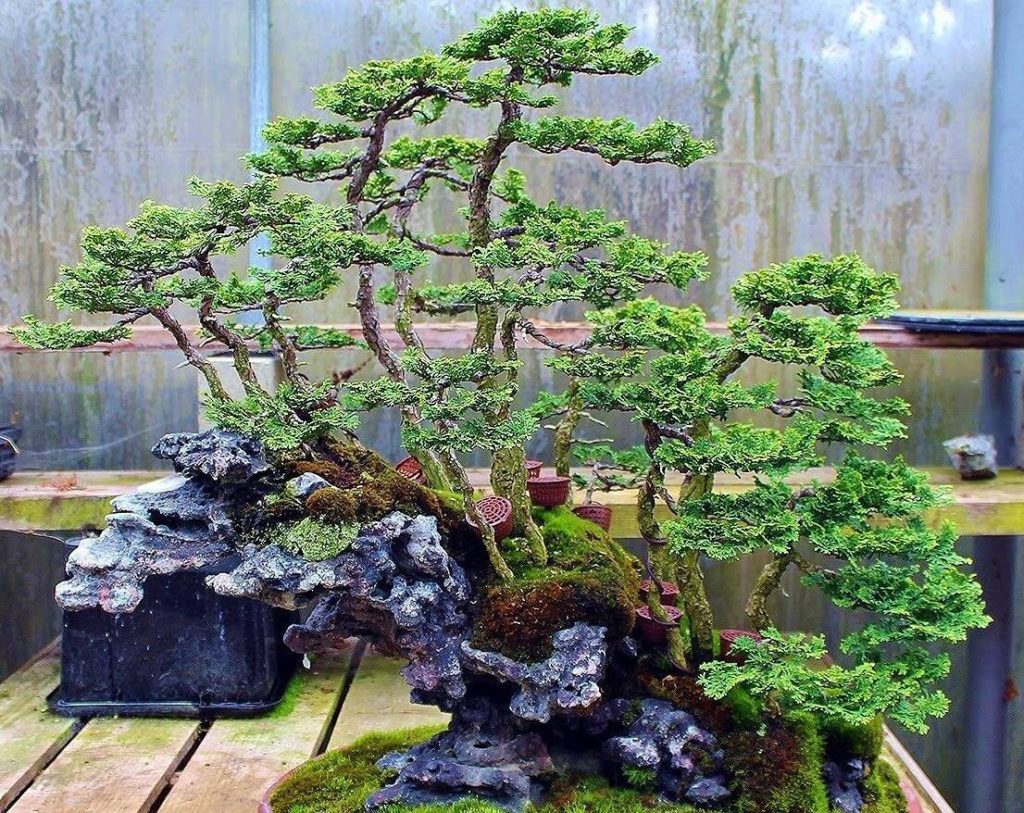
Bonsai Rock Planting Care Sheet
| Aspect | Care Tips |
| Watering | Check soil moisture regularly and water when necessary. |
| Water thoroughly until it drains from the bottom of the pot. | |
| Sunlight | Provide bright, indirect sunlight suitable for the species. |
| Temperature | Protect from extreme temperatures and frost. |
| Humidity | Ensure adequate humidity levels for the tree. |
| Fertilization | Use a balanced bonsai fertilizer during the growing season. |
| Follow the manufacturer’s instructions for dosage. | |
| Pruning and Trimming | Regularly prune to maintain desired form and remove excess growth. |
| Trim branches and foliage using appropriate bonsai tools. | |
| Wiring and Styling | Use wiring to shape branches carefully and gradually. |
| Avoid excessive bending that may damage the tree. | |
| Repotting | Repot every 1-3 years to refresh soil and prune roots. |
| Use fresh bonsai soil mix and ensure proper drainage. | |
| Pest and Disease Control | Regularly inspect for pests and diseases. |
| Use organic insecticides or horticultural oils if needed. | |
| Winter Care | Provide protection from freezing temperatures. |
| Avoid exposing the tree to sudden temperature changes. | |
| Regular Maintenance | Clean rocks regularly to preserve their natural beauty. |
| Adjust care routine based on the tree’s condition and needs. |
Please note that the care tips provided are general guidelines. It’s important to consider the specific needs and requirements of the bonsai tree species in your rock planting, as they may vary. Always observe the tree closely and make adjustments to the care routine as needed.
Conclusion
Planting bonsai rocks is a great way to show your imagination and bring a bit of nature into your home. By picking rocks and bonsai trees carefully and planting them in the right way, you can make beautiful tiny landscapes that will amaze and inspire people. With regular care and a little bit of patience, your bonsai rock planting will continue to grow and give you joy and peace for many years. So, accept this unique form of art and enjoy the process of planting bonsai rocks..
FAQ:
Q: What is a Bonsai Rock Planting?
A: A bonsai rock planting is a unique form of bonsai art in which a bonsai tree is planted with carefully chosen rocks to make a small landscape that looks like mountains or hills.
Q: How is a Bonsai Rock Planting different from regular bonsai?
A: A bonsai rock planting incorporates rocks as an integral part of the composition, creating a harmonious landscape. The rocks add an additional dimension and aesthetic appeal to the traditional art of bonsai.
Q: Are specific types of rocks used in bonsai rock plantings?
A: There are no strict rules regarding the types of rocks used. However, rocks with interesting shapes, textures, and colors are commonly chosen to enhance the naturalistic look of the composition.
Q: What are the symbolic meanings associated with bonsai rock plantings?
A: Bonsai rock plantings often symbolize endurance, strength, and the power of nature. The combination of the resilient bonsai tree and the rugged rocks represents the harmony between the elements and the ability to overcome challenges.
Q: Can any type of bonsai tree be used in a rock planting?
A: Yes, a variety of bonsai tree species can be used in a rock planting. The choice of tree depends on personal preference and the desired effect. However, it’s important to consider the growth habits and specific care requirements of the tree species.
Q: How do you care for a bonsai rock planting?
A: Proper care includes watering the tree appropriately, providing adequate sunlight and temperature conditions, regular pruning and shaping, fertilizing as needed, protecting from pests and diseases, and repotting when necessary.
Q: Can I create my own bonsai rock planting?
A: Yes, creating your own bonsai rock planting can be a rewarding experience. It requires careful selection of rocks, choosing a suitable bonsai tree, and arranging them in a visually appealing and harmonious composition.
Q: Can bonsai rock plantings be displayed indoors?
A: Yes, you can bring bonsai rock plants inside. But it’s important to make sure the tree gets enough light and that the inner setting has the right temperature and humidity.
Q: How long does it take for a bonsai rock planting to mature?
A: The time it takes for a bonsai rock planting to develop is determined by several factors, including the tree’s species, growth rate, and care offered. A bonsai rock planting might take years, if not decades, to properly mature and reach the intended appearance.
Q: Can I make changes to the composition of a bonsai rock planting over time?
A: Yes, bonsai rock plantings can be adjusted and refined over time. As the tree grows and matures, you may need to make pruning and shaping changes. You can also add or rearrange rocks to maintain the balance and overall design of the composition.
Q: Are there specific rules or guidelines for arranging the rocks in a bonsai rock planting?
A: While there are no strict rules, it’s important to create a natural and harmonious composition. Avoid symmetry and aim for asymmetrical arrangements that mimic the randomness of nature. Experiment with different placements until you achieve a visually pleasing design.
Q: Can I change the rocks in my bonsai rock planting?
A: Yes, the rocks in your bonsai rock planting can be changed if you want to. But it’s important to be careful so as not to hurt the bonsai tree’s roots. When making changes, make sure the new rocks are in a safe place and that the general look of the arrangement isn’t changed.
Q: How often should I water my bonsai rock planting?
A: The frequency of watering depends on various factors such as the tree species, pot size, and environmental conditions. It’s best to check the soil regularly by inserting a finger into the soil to assess its moisture level. Water when the soil feels slightly dry, ensuring that you water thoroughly until water drains out from the bottom of the pot.
Q: Do bonsai rock plantings require special fertilization?
A: Bonsai rock plantings benefit from regular fertilization to provide essential nutrients. Use a balanced bonsai fertilizer during the growing season, following the manufacturer’s instructions for the appropriate dosage. Adjust the frequency of fertilization based on the specific needs of the tree and the growth rate.
Q: Can I wire and shape the branches of the bonsai tree in a rock planting?
A: Yes, you can wire and shape the branches of the bonsai tree in a rock planting. Wiring allows you to guide the growth of the branches and achieve the desired form. However, be cautious not to wire the branches too tightly to avoid damaging or scarring the tree.
Q: How do I protect my bonsai rock planting from pests and diseases?
A: Regularly inspect your bonsai tree and rocks for any signs of pests or diseases. Use organic insecticides or horticultural oils if needed, following the instructions carefully. Ensure proper air circulation around the tree and maintain good hygiene practices to prevent the development of fungal diseases.
Q: How do I prepare my bonsai rock planting for winter?
A: Before winter arrives, protect your bonsai rock planting from freezing temperatures by moving it to a sheltered location or providing insulation. Avoid exposing the tree to sudden temperature changes, and consider using frost protection techniques like frost blankets or mulching around the base of the tree.
Q: Can I leave my bonsai rock planting unattended for extended periods?
A: Regular care and upkeep are required for bonsai rock plantings. While certain species may take brief periods of neglect, it’s preferable to have someone look after your bonsai tree if you’re going to be gone for an extended amount of time. Plan for watering, trimming, and other required maintenance duties to keep your bonsai rock planter healthy and vibrant.
Also Read:


